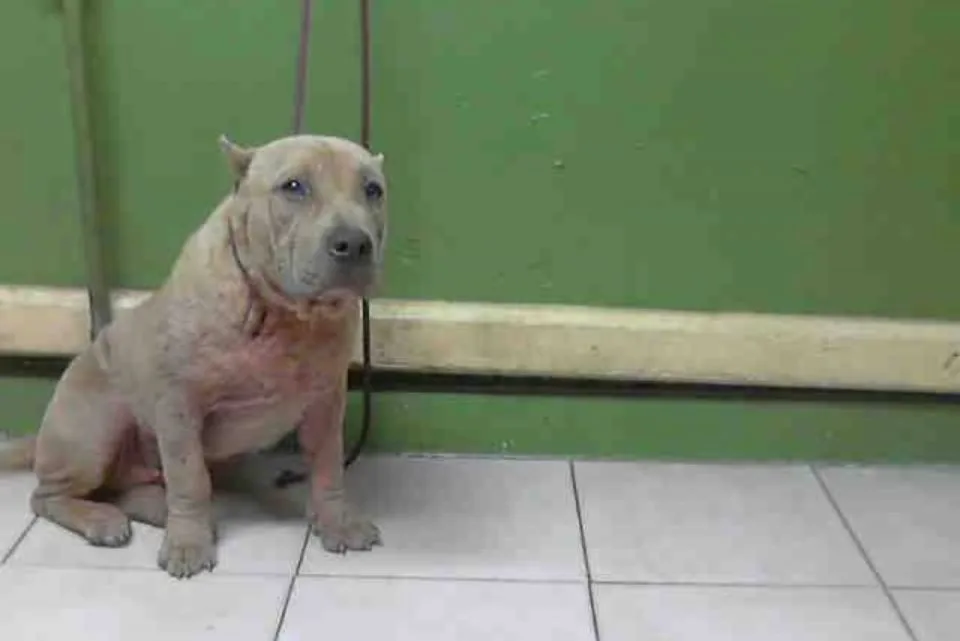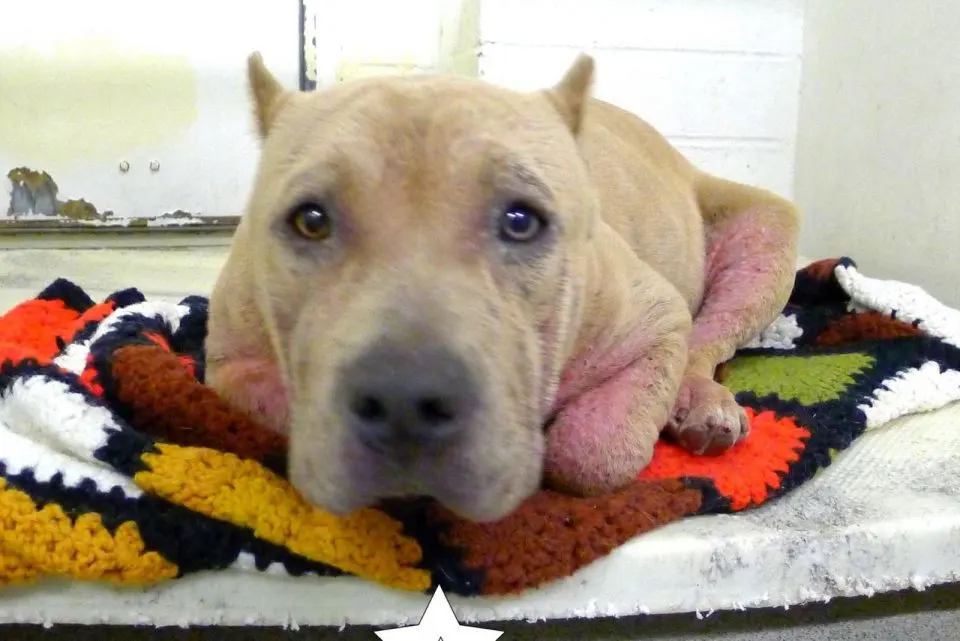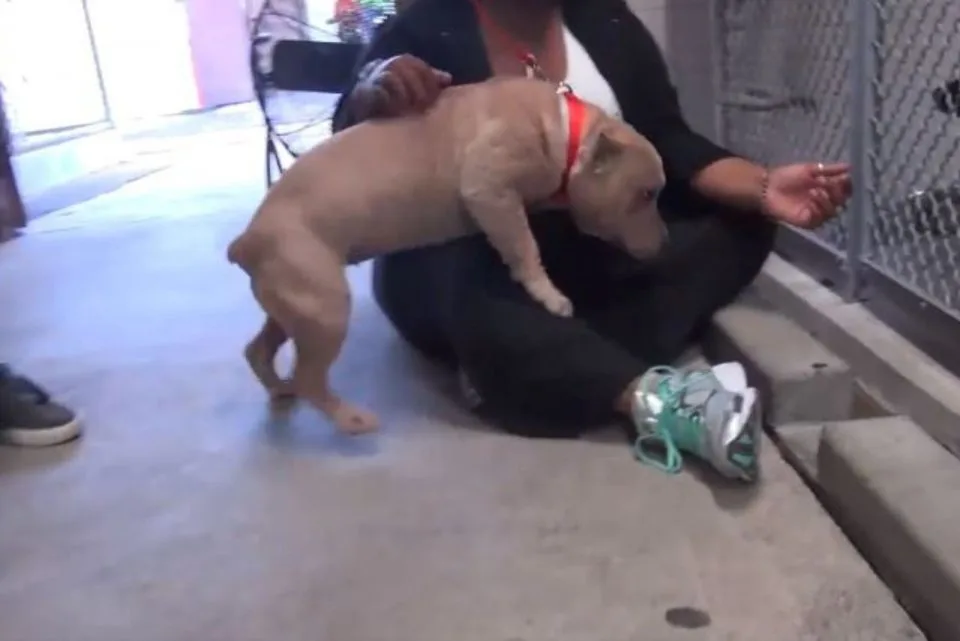Every doggo is beautiful in its own way. Their beauty might not always be clearly visible, especially if they’ve been treated wrongly for a long time, but you know it’s there from the moment you see them.
Unfortunately, not all pooches have the chance to grow up in a warm home filled with cuddles, care, and love. Some doggies go through horrific experiences of being neglected, abused, and unwanted.
Although it hurts me to see a stray dog, some pups might even be better on the streets rather than with an abusive and irresponsible owner.
A Puppy In Pain

One of the doggos that wasn’t so lucky to be raised in a loving family is Aimee, a Pittie from California that came into the Carson Animal Care Center with severe damage on her skin, which is why she was constantly feeling pain and discomfort.
At just six months of age, Aimee was looking far worse than the majority of older dogs in the shelter, so there wasn’t a big chance that someone would adopt her, especially because of her breed.
Aimee’s physical pain was gone with the right treatments for her skin, but seeing visitors just passing by her in the shelter broke her heart.
But, the staff didn’t want to give up on her. They were aware of all the great things Aimee has to offer her new family, and that if only the right people heard of her, she would already be in her new home.
New Picture For A New Home

Considering that people didn’t even notice her in the shelter, the staff came up with the idea of taking a cute picture of Aimee and posting it online.
They took a colorful blankie to give the picture a more cheerful vibe, but the look on Aimee’s face was what immediately attracted a great number of people interested in adopting her.
Her puppy eyes and sad look revealed how much she was yearning for a warm home and a loving family. Soon, her wish came true.

Aimee’s new family was happy to get another member, but no one could be happier than Aimee – she was running around the shelter so excited when they came to pick her up that she had no idea what she was doing.
The staff from the shelter posted a video describing Aimee’s behavior as a “freedom run”, which it was in a way, considering how much she waited for someone to come and take her home.
As it can be seen from the video, Aimee got a new name as well – Phoenix, which is symbolic considering that she started a new life with a family that will give her all the love and attention she deserves.
If you’ve ever noticed your furry friend gnawing at their paws, you’re not alone. It’s a common behavior that can leave you wondering what’s going on in your pup’s mind. Paw biting in dogs can range from an occasional itch to a persistent habit, and understanding the reasons behind it is key to helping your canine companion feel their best. As a seasoned dog trainer, I’ve encountered this behavior in many pups, each with their unique story to tell.
Your dog’s paws are more than just cute little footprints – they play a crucial role in their daily activities. From grooming to signaling discomfort, a dog’s paws are a window into their well-being. So, the next time you catch your furry friend nibbling away, it might be their way of communicating something important. Let’s take a closer look at the possible reasons behind this common canine behavior.
Understanding the Behavior: Why Do Dogs Bite Their Paws?
The Basics of Canine Behavior
When it comes to understanding why dogs bite their paws, it’s crucial to consider basic canine behavior. Dogs may bite their paws for various reasons, ranging from a simple itch to more serious issues. It’s essential to observe your dog’s behavior and look for any patterns or triggers that may be causing this habit.
Signs Your Dog May Have a Paw-Biting Habit
Recognizing the signs that your dog may have a paw-biting habit is important for addressing the issue. If you notice your dog frequently licking or chewing on their paws, redness or irritation on the paw pads, or limping after paw-biting episodes, it could indicate a problem. Checking for any underlying medical conditions or consulting a veterinarian is crucial to ensure your dog’s well-being.
Common Causes of Paw-Biting in Dogs
Allergies and Skin Irritations
If your dog is constantly biting their paws, allergies or skin irritations could be the culprit. Similar to how humans react to allergens, dogs can also have allergic reactions that lead to itchy paws. It’s essential to identify potential allergens in your dog’s environment, such as certain foods, plants, or even grooming products, that may be triggering this behavior. Consulting with your vet can help pinpoint the specific allergy and provide appropriate treatment.
Injuries and Pain
In some cases, paw-biting can be a result of injuries or underlying pain in your dog’s paws. Your dog might be trying to alleviate discomfort by nibbling or biting at the affected area. It’s crucial to carefully examine your dog’s paws for any signs of injury, such as cuts, splinters, or foreign objects lodged between the pads. If you notice any abnormalities or your dog shows signs of pain, seeking veterinary care is important to address the issue promptly.
Parasites and Infections
Parasites like fleas, ticks, or mites can cause irritation and itchiness in your dog’s paws, leading them to bite or chew on them excessively. Additionally, fungal or bacterial infections can also result in paw discomfort, prompting your dog to engage in paw-biting behavior. Regular grooming and preventive measures against parasites can help reduce the risk of infestations that may contribute to paw-related issues. Consulting your vet for appropriate parasite control and treating infections promptly is essential for your dog’s well-being.
Psychological Factors
Sometimes, paw-biting in dogs can be linked to psychological factors such as anxiety, boredom, or stress. Dogs may engage in self-soothing behaviors like paw-biting when they feel anxious or under-stimulated. Addressing any underlying emotional triggers through proper exercise, mental stimulation, and a comforting environment can help alleviate the urge for your dog to excessively bite their paws. Consulting with a professional trainer or behaviorist can provide insights into managing behavioral issues that may be contributing to this behavior.
Diagnosing the Issue
When to Visit the Vet
If you notice persistent paw-biting despite trying different strategies, it’s time to consult a vet. A professional can rule out underlying health issues, provide proper diagnosis, and recommend appropriate treatment.
What Tests and Examinations to Expect
During the vet visit, expect tests like skin scrapings to check for mites, blood tests to detect allergies, and physical examinations to assess any injuries. These evaluations help identify the root cause of your dog’s paw-biting behavior, leading to targeted solutions tailored to your furry friend’s needs.
Treatment and Prevention Strategies
Medical Treatments for Underlying Conditions
When it comes to addressing paw-biting in dogs caused by underlying medical conditions, veterinary treatment is vital. Your vet may conduct tests like skin scrapings for mites, blood tests for allergies, or physical examinations to pinpoint the issue. Based on the diagnosis, they’ll recommend specific treatments tailored to your furry companion’s needs, ensuring effective management of the condition.
Behavioral Interventions and Training
Behavioral interventions and training play a crucial role in curbing paw-biting tendencies in dogs. By working with a professional dog trainer or behaviorist, you can identify triggers, such as anxiety or boredom, and implement corrective measures. Through positive reinforcement techniques, like rewarding good behavior, you can help your dog overcome paw-biting habits and redirect their focus to more appropriate activities, fostering a healthier mindset.
Home Remedies and Care Tips
In addition to professional assistance, incorporating home remedies and care tips can complement treatment strategies. Simple steps like keeping your dog’s paws clean and dry, ensuring regular grooming to spot any issues early, and providing ample exercise to alleviate boredom can aid in preventing excessive paw-biting. Moreover, creating a stimulating environment with engaging toys and activities can help distract your dog from this behavior, promoting overall well-being.
Remember, a holistic approach combining medical treatments, behavioral interventions, and attentive care is key to effectively managing and preventing paw-biting in your beloved furry friend. By understanding the root cause and implementing appropriate strategies, you’ll support your pet in leading a happy and healthy life free from unnecessary discomfort.
Monitoring Your Dog’s Progress
Keeping a Behavior Diary
Start by jotting down when and where your dog bites its paws. Note any possible triggers such as certain times of the day or specific activities. A diary can help you spot patterns and understand what might be causing this behavior. This simple practice can be insightful for you and your vet.
Recognizing Improvement and Setbacks
Keep an eye on any changes in your dog’s behavior. Look out for a decrease in paw-biting incidents or any new signs of distress. Celebrate small wins when you notice improvements, like reduced redness or less licking. On the flip side, be alert to any setbacks and consider possible reasons for them. Monitoring progress is key to addressing the issue effectively.
Conclusion
That’s the lowdown on why your furry friend might be nibbling on their paws. Remember, understanding their behavior and seeking veterinary advice are key. Keep an eye out for allergens, injuries, parasites, and emotional triggers. By taking proactive steps like cleaning their paws, seeking professional help, and monitoring progress, you can help your pup find relief and live their best paw-biting-free life. Stay pawsitive and give your dog the care and attention they deserve!
Frequently Asked Questions
Why do dogs bite at their paws?
Dogs may bite at their paws due to various reasons including allergies, injuries, parasites, anxiety, or boredom. Observing patterns and seeking veterinary advice can help identify the root cause.
How can I help my dog stop biting its paws?
To help your dog stop biting its paws, consider identifying allergens, checking for injuries, preventing parasites, addressing emotional triggers like anxiety through exercise, and seeking professional guidance for behavioral interventions.
What treatments are available for dogs that bite at their paws?
Treatment options for dogs that bite at their paws include veterinary care to address underlying medical conditions, behavioral interventions with professionals to identify triggers, and home remedies like regular grooming and mental stimulation. Monitoring progress is essential for effective management.
[no_toc]

Hey there, I’m Janet Brooks, a dog-loving student from California. I’m all about helping pups in need, especially those without homes. Me and my awesome friends work together to give shelter and love to stray dogs. Oh, and I also write blogs about dogs to share helpful info.